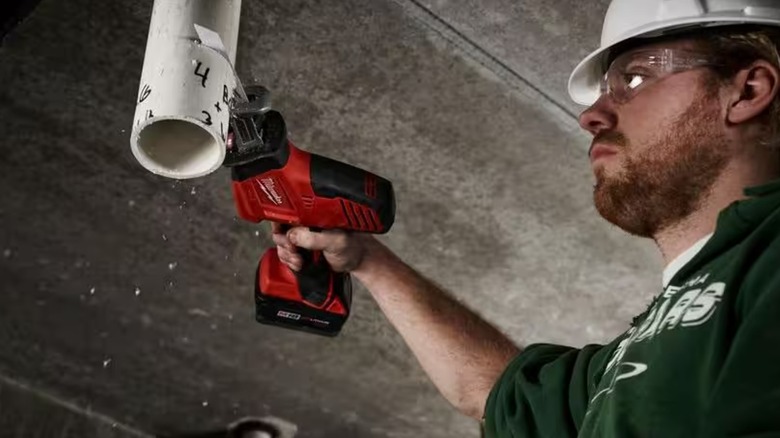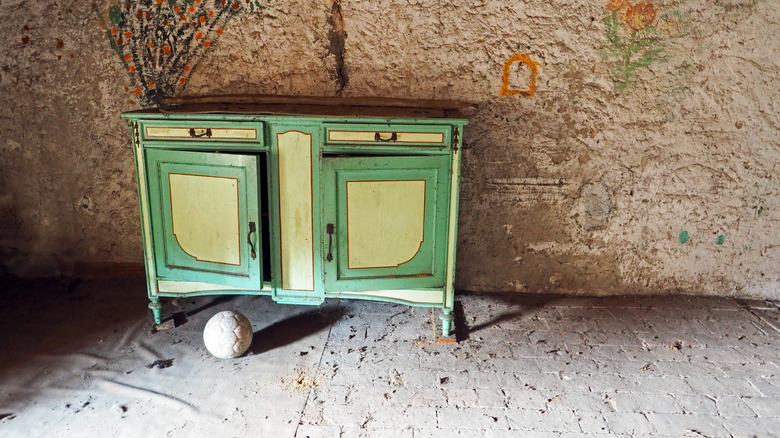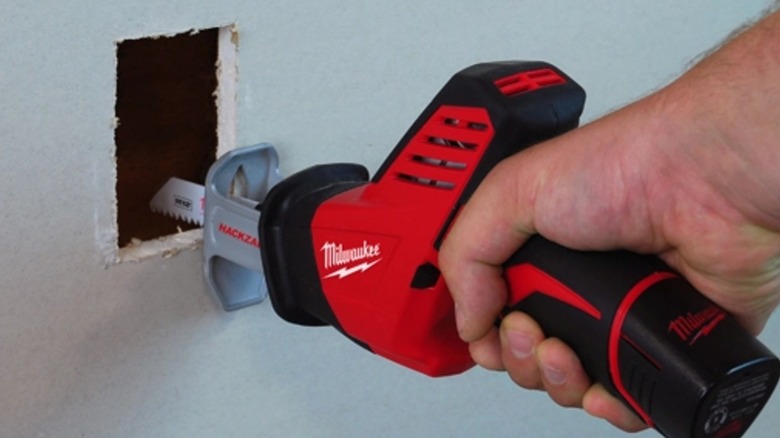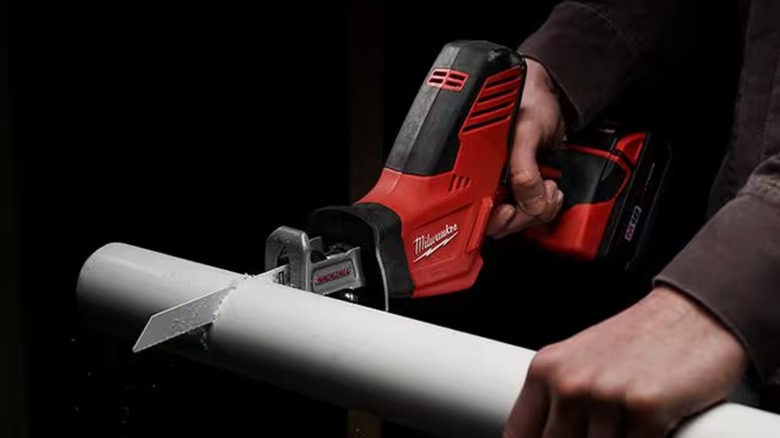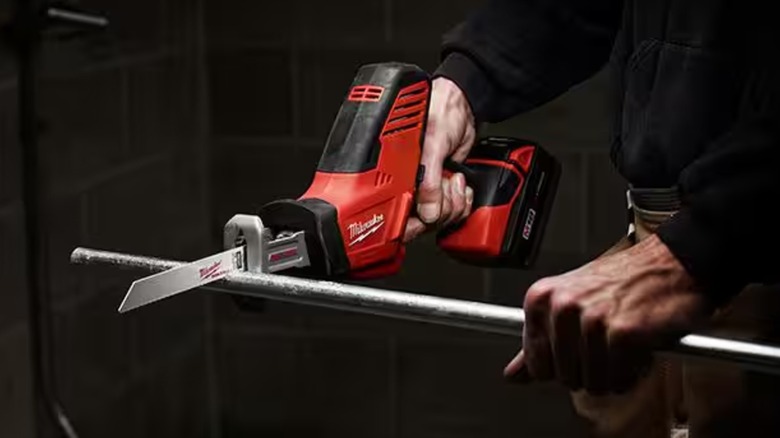5 Handy Uses For A Milwaukee Hackzall
The key to getting the most use out of your power tools is to broaden your expectations of their applications. In simpler terms, rather than buying a power tool to do exactly one thing, realizing you can accomplish a variety of different tasks will save you time and money in the long run.
Let's say, for example, you buy a Hackzall tool from the Milwaukee hardware brand. Milwaukee's Hackzalls are some of the brand's highest-rated power tools, but what are you supposed to use them for? Well, it's a handy, reasonably powerful cutting gadget that you can operate with just one hand, and depending on which precise model you're using, like the M18 or MX FUEL, there might be additional helpful features like a reciprocating blade. Whether you're a professional contractor, a hobbyist tinkerer, or just a homeowner with some chores to take care of, a one-handed cutting device definitely has some uses here and there.
A Hackzall can cut off small tree branches
Everyone likes to have a house surrounded by lots of greenery, but no one ever said keeping healthy plant life was easy. Even a single small tree in your yard requires regular upkeep, particularly pruning off ugly or dead branches. A regular hand saw might take a little too much effort to easily remove these branches, but something like a chainsaw would be going a little too far in the opposite direction. If you want a good middle ground for tree maintenance, a Hackzall could definitely handle it.
If there are any small to medium-sized branches on your yard's trees or foliage that you want to cut down, a Milwaukee Hackzall will let you do it with one hand. If it's a particularly small tree, you can use your free hand to steady it; otherwise, if it's a slightly thicker branch, you can manage the Hackzall with both hands. It might not be enough for long, thick branches on old trees in massive forests, but if it's a couple of small planter trees in the backyard, that should be fine.
A Hackzall can help to break down old furniture
Here's an annoying scenario: let's say you've got some old furniture like a dresser or table stashed out of the way in an attic or crawlspace. You want to finally get rid of it and make some room, but the furniture is too large to easily move up a staircase or down a ladder, at least by yourself. It happens sometimes: you manage to squeeze furniture into one room of your home, but for some reason, it just won't go back the other way. If you need to cut some old junk down to a more manageable size, bust out the Hackzall.
If you've got furniture that's too large to transport up and down stairs or through a narrow hallway, you may be able to slash it into smaller chunks with the help of a Hackzall. So long as the furniture isn't too big and is made primarily of an easily cut material like wood, you can use your Hackzall to hack it into a handful of smaller bits. Not only will this make it much easier to carry downstairs and out of your house, but you might even be able to fit it in the trash can instead of just leaving it by the curb.
A Hackzall can be used to cut through drywall
Whether you're a professional contractor performing full-scale work or just a homeowner looking to make some small modifications to your domicile, the house's first line of defense will usually be the drywall. If you're trying to make any kind of extensive modifications to a house's infrastructure, there's a good chance you're going to need to cut through that drywall, either to get at stuff that's already back there or to add something new.
While there are various dedicated cutting tools for making incisions into drywall like Milwaukee's M18 Cut Out tool, if you've already got a Hackzall handy, you might not need them. While the default blade that comes with a Hackzall might not be ideal for this, Milwaukee does make a variety of different blades for different purposes. The multipurpose blade can handle drywall, featuring a shorter length to minimize overall damage to the structure and a reinforced body for general longevity. Stick this blade in your Hackzall, and you can make whatever small nooks in your drywall that you want.
A Hackzall can cut through both metal and PVC pipes
There's always a need for proper piping around the house. Both metal and PVC pipes are necessary for serving the various plumbing needs of your home, whether it's transporting hot water from a tank or drinking water from a reservoir. If you've already made an incision into your home's drywall with your Hackzall for the purposes of plumbing work, don't put it away just yet because you may be able to use it to cut some pipes down to size as well.
A Hackzall is a great tool for cutting pipes of various materials into proper shapes and sizes for home plumbing purposes. In a similar vein to drywall, it might not be the best idea to go at pipes with the default Hackzall blade, but once again, just swap the blade out, and you're off to the races. Milwaukee makes specialized multipurpose Hackzall blades for PVC and metal piping, small in size for tight confines, a thin kerf for more cuts per charge, and with reinforced bodies to last longer. You name a pipe, there's probably a Hackzall blade for it.
A Hackzall can cut through EMT for electrical installations
Metal tubes aren't just for carrying water around your house. They're also used for protecting electrical wire from the elements, not to mention the contents of other pipes and tubes snaking around nearby. This is called "electric metallic tubing," or "EMT," and it's vital for any professional electrical installation. While it's technically different from the steel pipes you'd use for plumbing installations, a metal pipe is a metal pipe. As we've established, a Hackzall can be used for cutting down metal pipes, whether they're carrying water or cradling wires.
If you're a contractor working on electrical installation, keep a Hackzall handy. When it comes time to install wiring, you can use your Hackzall, plus its specialized blade for steel-cutting, to cut EMT into the perfect size and shape for a safe and perfectly sized installation. And hey, if nobody's made that first cut into the drywall yet, you can take care of that yourself with your Hackzall. Just remember to change the blade after you finish cutting the drywall.
